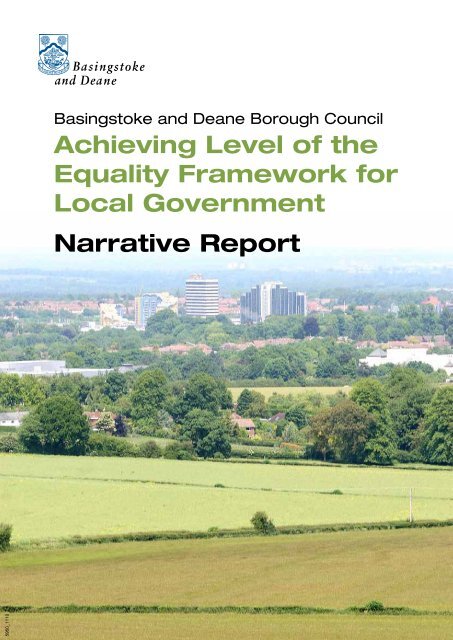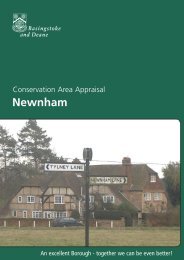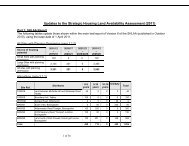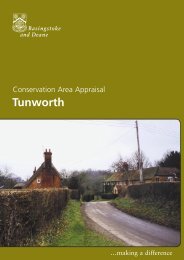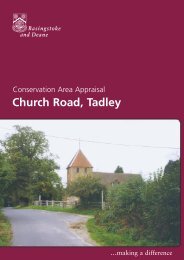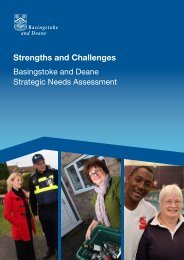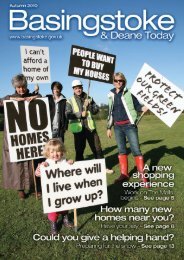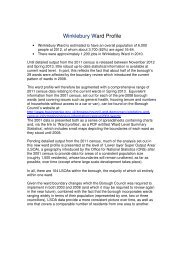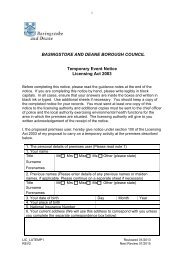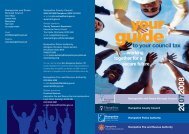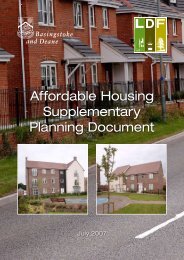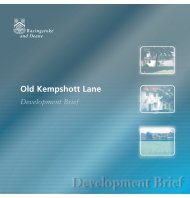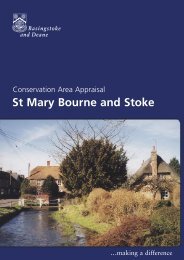Narative report - Basingstoke and Deane Borough Council
Narative report - Basingstoke and Deane Borough Council
Narative report - Basingstoke and Deane Borough Council
Create successful ePaper yourself
Turn your PDF publications into a flip-book with our unique Google optimized e-Paper software.
<strong>Basingstoke</strong> <strong>and</strong> <strong>Deane</strong> <strong>Borough</strong> <strong>Council</strong>Achieving Level of theEquality Framework forLocal GovernmentNarrative Report5950_1110
ForewordWe want the borough of <strong>Basingstoke</strong> <strong>and</strong> <strong>Deane</strong> to be a place where no-oneexperiences discrimination or disadvantage because of race, nationality, culture orethnic origin, religion or belief, gender, marital status, sexuality, disability, age orany other unlawful reason.As a council we are committed to work to reduce disadvantage, discrimination, <strong>and</strong>inequality of opportunity. We are committed to promoting diversity in terms of thepeople we serve, our workforce, the partners we work with <strong>and</strong> the services wedeliver.We have legal duties relating to equality <strong>and</strong> we are determined to meet these.However, our aim is not just to meet our legal duties, but to make our borough aplace where everyone matters <strong>and</strong> is treated equally, in the light of their differentneeds.We want everyone in <strong>Basingstoke</strong> <strong>and</strong> <strong>Deane</strong> to feel safe from harassment <strong>and</strong> tohave access to high quality services designed to respond to their individual needs.We want our workforce to reflect the diversity of our community – if it doesn’t, wecould be missing out on the skills, knowledge <strong>and</strong> experience within all sections ofthe community.We have a responsibility to provide community leadership for the borough <strong>and</strong> willuse this to promote equality <strong>and</strong> share ideas <strong>and</strong> good practice with our partners<strong>and</strong> other service providers.The borough council is committed to consulting the public, its service users,partners <strong>and</strong> other interested groups as part of providing effective services thatmeet the needs of the people of <strong>Basingstoke</strong> <strong>and</strong> <strong>Deane</strong>. By seeking residents’views <strong>and</strong> using the results, the council can ensure that its services better reflectcommunity needs <strong>and</strong> aspirations.Karen BrimacombeCorporate DirectorCllr Clive S<strong>and</strong>ersPortfolio Holder for Communities, Sport<strong>and</strong> Leisure2
Key areasThe five main areas of the Achieving Level for the Equality Framework for LocalGovernment that the council has worked towards are:Knowing our community – equality mappingPlace shaping, leadership, partnershipCommunity engagement <strong>and</strong> satisfaction <strong>and</strong> organisationalcommitmentResponsive services <strong>and</strong> customer careA modern <strong>and</strong> diverse workforce3
<strong>Basingstoke</strong> <strong>and</strong> <strong>Deane</strong> <strong>Borough</strong>The borough of <strong>Basingstoke</strong> <strong>and</strong> <strong>Deane</strong> covers an area of over 245 square miles(over 63,000 hectares) in northern Hampshire, over 75% of which is agricultural orl<strong>and</strong> in other non-wooded greenfield use. A further 15% of the borough is coveredby woodl<strong>and</strong> or forest. Less than 8% of the borough is built up, supporting themajority of the borough’s population of over 165,000 people 1 .More than 60% of the population (over 100,000) lives in the town of <strong>Basingstoke</strong>.The second largest settlement in the borough is the Tadley /Baughurst /PamberHeath area, on the northern Hampshire boundary, with a population approaching16,000. The western part of the borough is dominated by the sparsely populatedNorth Wessex Downs Area of Outst<strong>and</strong>ing Natural Beauty. On the periphery ofthis area are several settlements of 3,000 to 5,000 population such as Overton <strong>and</strong>Whitchurch, both of which lie in the upper valley of the River Test. Elsewherenumerous small villages <strong>and</strong> hamlets are scattered throughout the borough.At the 2001 Census, the borough had a younger than average age profile with over25% of the population aged 19 or under <strong>and</strong> only 12.5% of the population aged 65or older. In the medium term, on the basis of current trends in life expectancy <strong>and</strong>migration, the over 65 age group is predicted to increase most rapidly, reachingmore than 30,000 people (17.5% of the total population) by 2016 2 .200,000<strong>Basingstoke</strong> <strong>and</strong> <strong>Deane</strong>Projected population growth by age group: 2001-2026180,000160,000140,000120,000100,00080,00060,00040,00020,00085+75-8465-7445-6430-4416-295-150-402001 2006 2011 2016 2021 20261 2009-based Small Area Population Forecasts HCC (2010)2 2009-based Small Area Population Forecasts HCC (2010)4
Unemployment is relatively low at around 5.9% 3 of the economically active workingage population 4 . This is slightly lower than the rate for the South East as a whole,<strong>and</strong> two percentage points lower than the national average. Over 80% of theborough’s working age population is economically active, higher than that of theregion or the country as a whole.<strong>Basingstoke</strong>’s strategic location on the national road <strong>and</strong> rail networks hascontributed to its success as an employment centre, with 83% of the <strong>Borough</strong>’sjobs located in <strong>Basingstoke</strong> town. The borough’s close proximity to London, to theports of Southampton <strong>and</strong> Portsmouth, <strong>and</strong> to Heathrow, Gatwick <strong>and</strong>Southampton airports, has also helped its commercial success.Commuting out of the borough to work in other nearby centre’s such as Newbury,Reading, or in London, is counter-balanced by those commuting into the boroughfrom other parts of Hampshire <strong>and</strong> surrounding counties. The borough’senterprises <strong>and</strong> businesses provide jobs for two thirds of its employed residents, ahigher ‘self sufficiency’ ratio than any other Hampshire district. Overall, theborough provides about 83,600 5 jobs, <strong>and</strong> is home to about 6,900 6 businesses.Average earnings levels compare favourably with wage levels for Hampshire <strong>and</strong>the South East <strong>and</strong> with national averages, but affordability of house prices is anissue for many of the borough’s younger residents. Recent developments haveincreased the proportion of smaller homes for one <strong>and</strong> two-person households.While the 2001 Census showed that levels of car ownership are generally high,there are some communities where up to 30% of households do not have accessto their own transport. While over 70% of borough residents travel to work by caror van, access to affordable transport in rural areas <strong>and</strong> in some parts of our townsremains an issue.The English Indices of Deprivation 2007 (ID2007) indicate that <strong>Basingstoke</strong> <strong>and</strong><strong>Deane</strong> experiences relatively little deprivation in the national context. When allindicators are combined into the ‘Index of Multiple Deprivation’ (IMD2007), onlyone of the borough’s geographical areas just falls within the 30% most deprived inEngl<strong>and</strong>. More than half fall within the least deprived 20% in Engl<strong>and</strong>, 5 of themwithin the 1% least deprived nationally. However, some parts of the borough,predominantly within <strong>Basingstoke</strong> town, experience relatively high levels ofdisadvantage in terms of education, crime <strong>and</strong> income.The Annual Population Survey (APS) indicates that over 33% of <strong>Basingstoke</strong> <strong>and</strong><strong>Deane</strong>’s working age population is educated to degree level or equivalent 7 – higherthan both national <strong>and</strong> regional averages. On average, GCSE results in recentyears have shown grades for the borough’s pupils to be around national levels interms of the percentage gaining 5 or more A* to C grades; <strong>and</strong> in terms of all3 Annual Population Survey, ONS: April 2009-March 2010 – model based unemployed4 This is now considered to be a more realistic measure of unemployment than the Job SeekersAllowance claimant count which st<strong>and</strong>s at about 2.7% (February 2010)5 Annual Business Inquiry employee analysis, ONS – employee jobs 20086 Business Demography, ONS – active businesses 20087 Annual Population Survey, ONS: January 2009-December 2009 – working age populationqualifications5
esults (pupils gaining five or more A* to G grades) they are higher than bothnational <strong>and</strong> Hampshire averages.However, the percentage of pupils gaining five or more GCSE grades at A* to Chas been lower than the Hampshire average in recent years, <strong>and</strong> there aresignificant differences in attainment levels between schools in different parts of theborough. The APS also shows that 10% of the working age population has noqualifications – lower than national average.There is a strong voluntary <strong>and</strong> community sector in the borough, with about 1,000active organisations. The 2008 ‘State of the Sector Report’ 8 examined a numberof local organisations in the borough, which showed they were supported by over8,000 volunteers. Information provided on volunteering hours revealed that 6,912volunteers provide a total of 817,251 volunteering hours per annum, with a value tothe local economy of between £6.4m <strong>and</strong> £12.2m.There are 24 community facilities <strong>and</strong> 65 village halls in the borough, where a widerange of activities take place, involving health services, education <strong>and</strong> learning,arts clubs, uniformed groups, social clubs <strong>and</strong> events, <strong>and</strong> sporting activities. Thevoluntary <strong>and</strong> community sector also works alongside the statutory organisations,delivering highly valued services to the public.Residents enjoy a wide range of publicly provided leisure services <strong>and</strong> facilities in<strong>and</strong> around the borough such as arts venues, museums <strong>and</strong> sports facilities,parks, local nature reserves <strong>and</strong> woodl<strong>and</strong>s. This is complemented by a range ofprivate sector attractions such as cinemas, health clubs, golf <strong>and</strong> tennis clubs <strong>and</strong>equestrian facilities. 87% of borough residents feel that <strong>Basingstoke</strong> <strong>and</strong> <strong>Deane</strong> isa good place to live 9 - this is higher than county, regional or national averages.‘Experimental’ population estimates by ethnic group, released by the Office forNational Statistics (ONS), cover the period 2001-2007. Bearing in mind theexperimental status of these estimates, they indicate that whilst the overallpopulation of the borough increased by 7,200 over the 6-year period 2001-2007,the ‘White British’ population increased by only 500. The first time-series graphbelow shows how the population within each broad ethnic group in the borough isestimated to have changed between 2001 <strong>and</strong> 2007.8 State of the Voluntary <strong>and</strong> Community Sector in the <strong>Borough</strong>, <strong>Basingstoke</strong> Voluntary Services 2008.9 . Place Survey 20086
6<strong>Basingstoke</strong> & <strong>Deane</strong>Estimated population change within broad minority ethnic groupsThous<strong>and</strong>s.....54321White: IrishWhite: White non-British or IrishMixedAsian or AsianBritishBlack or BlackBritishChinese or OtherEthnic Group02001 2002 2003 2004 2005 2006 2007Source: Population Estimates by Ethnic Group (experimental), ONSThe two broad ethnic groups with the highest rates of growth can be clearlyidentified as: White (non-British or Irish), increasing by 2,200 to reach 5,300; <strong>and</strong> Asian or Asian British, increasing by 2,300 to reach 4,200.The second time-series graph shows a more detailed breakdown of change withinthe non-White ethnic groups in the borough.2,5002,0001,5001,0005000<strong>Basingstoke</strong> & <strong>Deane</strong>Estimated population change within non-White ethnic groupsMixed: White <strong>and</strong> Black CaribbeanMixed: White <strong>and</strong> Black AfricanMixed: White <strong>and</strong> AsianMixed: Other MixedAsian or Asian British: IndianAsian or Asian British: PakistaniAsian or Asian British: BangladeshiAsian or Asian British: Other AsianBlack or Black British: Black CaribbeanBlack or Black British: Black AfricanBlack or Black British: Other BlackChinese or Other Ethnic Group: ChineseChinese or Other Ethnic Group: Other2001 2002 2003 2004 2005 2006 2007Source: Population Estimates by Ethnic Group (experimental), ONSThe local Indian population is clearly identified as the fastest growing non-Whitegroup over the period 2001-2007, having doubled to reach an estimated 2,400.This accounts for well over half the total growth within all Asian or Asian Britishgroups. Whilst no other group accounts for more than 1,000 people within theborough at 2007, notable changes over the period 2001-2007 are identified withinthe Pakistani population (which increased by 700 to reach 900), the Black Africanpopulation (which increased by 600 people to reach 900) <strong>and</strong> the Chinesepopulation (which increased by 600 people to reach 1,000).7
1. Knowing our community – equality mappingInformation is gathered across the council using a range of techniques to informthe <strong>Council</strong> Plan (2010-2013), the Sustainable Community Strategy<strong>and</strong> other strategies <strong>and</strong> to identify equality gaps, for example, consultation <strong>and</strong>satisfaction survey results, census mid year estimates, Indices of MultipleDeprivation etc <strong>and</strong> local knowledge. Analysis of this information concludes thatthe priority groups who present challenges for the council are children <strong>and</strong> youngpeople in our more deprived wards <strong>and</strong> older people, particularly facing an ageingcommunity in future years.Strong links are developed with our communities through our 60 councillors, thepolitical structure is: 34 Conservative, 14 Liberal Democrat, 9 Labour, 2Independent <strong>and</strong> 1 <strong>Basingstoke</strong> First Community Party. Each councillor is electedto represent a ward of the borough by the voters in that ward. Depending on theirelectorate, wards have 1, 2 or 3 councillors to represent them on the boroughcouncil. <strong>Borough</strong> councillors are elected for 4 years: a third of the council comesup for election each year (except in the year when there is a Hampshire County<strong>Council</strong> Election). The council agrees what services to provide, the policies to befollowed in delivering these, the spending plans <strong>and</strong> the borough council’s part ofthe council tax. The council, with a number of committees, also scrutinises thedecisions of the Leader <strong>and</strong> Cabinet Members of the borough council. The officerteam is led by the Chief Executive <strong>and</strong> 2 directors <strong>and</strong> services are delivered by 9business units - Environmental Care; Finance, Local Tax <strong>and</strong> ICT; Governance<strong>and</strong> Customer Support; Housing <strong>and</strong> Benefits; Legal <strong>and</strong> Democratic Services;Neighbourhood Development; Planning <strong>and</strong> Transport; Property <strong>and</strong> FacilityManagement <strong>and</strong> Strategy <strong>and</strong> Innovation (see organisational structure). Threemembers of the Cabinet are female, although the overall number of womencouncillors is 30% <strong>and</strong> 7% are from ethnic minorities <strong>and</strong> some of our councillorsalso have disabilities.Our journey towards the Achieving Level of the EFLGThe council resolved in May 2002 that we should work towards the EqualitySt<strong>and</strong>ard for Local Government. The council self certified that we had achievedLevel 2 of the Equality St<strong>and</strong>ard in 2002/03. To demonstrate our commitment toequality the council included a specific requirement to consider equality whenpreparing <strong>report</strong>s to go to committees <strong>and</strong> cabinet.The council adopted a Corporate Equality Policy in 2006 (Corporate Equality Plan2006-2009). An equality officer post was established in 2007; a significant part ofthat role was to progress equality across the council.The council agreed in January 2009 to support the attainment of the‘Achieving‘Level of the new Equality Framework for Local Government (EFLG).8
The council’s Equality Plan has been reviewed <strong>and</strong> updated <strong>and</strong> a Single EqualityScheme has been developed replacing the 3 schemes <strong>and</strong> statements for theother equality str<strong>and</strong>s to include all 7 str<strong>and</strong>s. Both of these documents have beenconsulted on with service users, partners, the union <strong>and</strong> Staff Consultative Group.The scheme now reflects our new corporate objectives.The Corporate Equality Working Group, with a member of staff from each businessunit, <strong>and</strong> the Equality Strategy Group (cross party) were set up in 2009.Our work around the equality framework has seen us make a number ofimprovements in the equality mapping resources we have <strong>and</strong> the way we usethem to underst<strong>and</strong> our community better <strong>and</strong> support improved decision making.MosaicAt a time when public expectations of local services are growing while public fundsare declining, the need for greater underst<strong>and</strong>ing of our customer needs <strong>and</strong>preferences has never been more important. In order to put our customers first,we need to know them better. We have invested in Mosaic customer insight. Thisproduct provides a systematic approach to underst<strong>and</strong>ing the diversity of ourcommunities <strong>and</strong> will enable us to deliver joined-up services which respond todifferent needs <strong>and</strong> wishes.By combining Mosaic with information we already gather we have been able tobring different information sources from the various areas across the counciltogether in one place to build a rich picture.Percentage of Households in BDBC18.00%16.00%14.00%12.00%10.00%8.00%6.00%4.00%2.00%0.00%Group HGroup DGroup FGroup KGroup EGroup B11,17410,2929,0527,5426,2895,2524,9373,6552,7232,1251,8621,7311,1341,091550Group JGroup AGroup BGroup GGroup IGroup LGroup CGroup OGroup N9
Mosaic Group Group Description Mosaic Group Group DescriptionGroup A Residents of isolated rural communities Group ILower income workers in urban terraces in oftendiverse areasGroup BResidents of small <strong>and</strong> mid-sized towns withOwner occupiers in older-style housing, typicallyGroup Jstrong local rootsin ex-industrial areasGroup CWealthy people living in the most sought-afterResidents with sufficient incomes in right-to-buyGroup Kneighbourhoodssocial housingGroup DSuccessful professionals living in suburban orActive elderly people living in pleasant retirementGroup Lsemi-rural homeslocationsGroup EMiddle income families living in moderatesuburban semisGroup M Elderly people reliant on state supportGroup FCouples with young children in comfortableYoung people renting flats in high density socialGroup Nmodern housinghousingGroup G Young, well-educated city dwellers Group OFamilies in low-rise social housing with high levelsof benefit needGroup HCouples <strong>and</strong> young singles in small modernstarter homes2. Place shaping, leadership, partnership <strong>and</strong> organisationalcommitmentThe <strong>Council</strong> Plan 2010 to 2013 demonstrates our commitment to embeddingequality in everything we do. We have delivered a number of outcomes as part ofour corporate objectives <strong>and</strong> priorities to address the needs of vulnerable people,people in more deprived areas <strong>and</strong> young people.Corporate Objective: To maintain <strong>and</strong> enhance local community wellbeingSome outcomes:‣ Exceeded our target for affordable homes giving residents more choice ofhousing options‣ Launched a new choice based lettings scheme‣ Started building work on a new £11.8m innovative ‘extra care’ housingdevelopment for older people.‣ Set up a new team of community development officers helping residents indifferent areas across the borough to set up their own groups to meet localneeds, for example, youth clubs, holiday clubs <strong>and</strong> exercise sessions topromote healthier lifestyles.Corporate Objective: To build <strong>and</strong> sustain a strong focus on inclusionSome outcomes:‣ Set up a new Court Desk Service at <strong>Basingstoke</strong> County Court to helpmortgage holders or tenants facing repossession or eviction.‣ Supported Hampshire Fire Brigade in the LIFE programme, inspiringidentified young people to get involved <strong>and</strong> be part of the wider community.10
Alongside this are the council’s equality objectives in the Equality Plan,which demonstrate our commitment to continue to embed equality <strong>and</strong> diversity inemployment practices <strong>and</strong> the services of the council <strong>and</strong> work with partners to setequality objectives.CEP1: We will make <strong>Basingstoke</strong> a welcoming place for everyoneCEP2: We will make sure relevant services are accessible to all.CEP3: We will provide fair treatment that meets individual needsCEP4: We will ensure that we have a modern <strong>and</strong> diverse workforce thatreflects the working population of the borough.Integrated into partnership strategiesThe Sustainable Community Strategy is currently under review, however progresshas been delayed subject to government announcements on the requirementunder the national performance framework. The SCS vision has been agreed,which has many statements that support equalities, <strong>and</strong> agreed priorities focus onyoung people <strong>and</strong> older people around encouraging involvement.Development of the vision included wide involvement - with the public <strong>and</strong>stakeholdersPriorities were generated <strong>and</strong> further consulted on through wide engagement withpartners. Priorities have been agreed among partners.A position statement for the SCS includes the agreed views of partners on thefuture direction of the borough, its strengths <strong>and</strong> challenges, both now <strong>and</strong> lookingfurther into the future.<strong>Basingstoke</strong> Area Strategic Partnership (BASP) support for diversityBASP project funding is focussed on projects that can show commitment to thepriorities set out in the SCS, the LAA <strong>and</strong> the Neighbourhood Renewal Strategy.Funding has supported young people, older people, those at risk of not being ineducation, employment or training (NEETs), disabled access to allotments <strong>and</strong>celebrating world arts.Detailed information is available on the <strong>Basingstoke</strong> Area Strategic Partnershipwebsite, BASP Project FundingUnderst<strong>and</strong>ing diverse communitiesReport to BASP Board on underst<strong>and</strong>ing the diversity of the community – May2008, with supporting paper.Organisational commitment to equalityThe Corporate Equality Working Group includes a member of staff from eachbusiness unit, a union representative, JSCF representative (Joint StaffConsultative Forum) <strong>and</strong> the customer services manager.11
The Equality Working Group challenges equality impact assessments, the deliveryof the Equality Action Plan <strong>and</strong> leads on developing good practice for the council.The Corporate Equality Strategy Group oversees <strong>and</strong> monitors the equality agendafor the council (see terms of reference including membership of the group)Embedding equality into the corporate performance frameworkEquality is embedded throughout our performance management framework (seethe performance framework diagram). Business plans contain equality impactassessments (EIAs) <strong>and</strong> related actions.Equality impact assessmentsOfficers undertaking EIAs receive training <strong>and</strong> are provided with support, guidance<strong>and</strong> demographic data to assist them. The toolkit for EIAs was updated in 2009 toensure that the 7 equality str<strong>and</strong>s are considered individually.Actions from EIAs form part of business plans <strong>and</strong> there are clear links betweenservice improvements. There are few adverse impacts found in EIAs - where theyhave been found the council has worked to mitigate them.Scrutiny <strong>and</strong> monitoringThe Community Wellbeing Overview <strong>and</strong> Scrutiny Committee receives an annualupdate <strong>report</strong> on progress in reaching the EFLG. The Equality Strategy Group <strong>and</strong>Personnel Committee monitors the progress made in embedding equality <strong>and</strong>diversity in the council. Heads of service are encouraged to update theirimplementation of the Equality Action Plan <strong>and</strong> actions resulting from EIAs on aquarterly basis.Procurement<strong>Basingstoke</strong> <strong>and</strong> <strong>Deane</strong> <strong>Borough</strong> <strong>Council</strong> recognises that individuals <strong>and</strong>communities may face unlawful <strong>and</strong>/or unfair discrimination on a variety ofgrounds.We believe that equality for all is a basic human right <strong>and</strong> actively oppose all formsof unlawful or unfair discrimination. We celebrate the diversity of our society <strong>and</strong>are striving to promote <strong>and</strong> reflect this diversity within the council’s own structure.As a major purchaser of goods, services <strong>and</strong> works, the council recognises theopportunity this provides to influence the equality agenda through procurement.The Local Government Equality St<strong>and</strong>ard has laid out specific equality inprocurement criteria to be included in contracts <strong>and</strong> achieved through theprocurement process. We are committed to ensuring that our major suppliers <strong>and</strong>contractors share our equality <strong>and</strong> diversity vision <strong>and</strong> values, <strong>and</strong> work toimplement these.It is the responsibility of staff involved in procurement activities to ensure thatequality is embedded in contracts <strong>and</strong> service provision.12
To ensure this, the council will:ensure our appointed contractors share <strong>and</strong> help deliver our equalityobjectivesprovide training/guidance for those staff involved in procurementThe Equalities <strong>and</strong> Human Rights Commission recognises that promoting equalityis more relevant to some functions than others, most notably those where there isinteraction between the contractor <strong>and</strong> council employees or members of thepublic.We have recently won the Federation of Small Business (FSB) Award for ‘BestSmall Business Friendly Procurement Policy’.We are also publishing information on what we spend in a ‘your right to know’section on our website.Commitment to equality is stated in the Procurement Strategy <strong>and</strong> procedureswhich had an EIA.The council provides core revenue grants to voluntary sector organisationsincluding <strong>Basingstoke</strong> CAB, Tadley CAB, <strong>Basingstoke</strong> Voluntary Services, AgeConcern, Relate, Home Start North West Hampshire, Shop Mobility, VictimSupport <strong>and</strong> the Young People’s Information Project. The council has alsoprovided funding to support the Disability Forum, Multicultural Forum <strong>and</strong> the Over55s’ Forum as well as smaller one-off grants for many years (see case study 2)3. Community engagement <strong>and</strong> satisfaction <strong>and</strong> organisationalcommitmentThe Place Survey results from autumn 2008 showed that in terms of overallsatisfaction, <strong>Basingstoke</strong> <strong>and</strong> <strong>Deane</strong> achieved the 5 th highest result of all 201district councils, <strong>and</strong> 12 th highest when compared to all 353 councils. Satisfactionwith services in general was above average.Satisfaction with the borough as a place to live had increased since the previoussurvey in 2006, up from 84% to 87%, <strong>and</strong> again above the national average. Theproportion of people who felt they could influence decisions had increased from thesurvey in 2006 by 5% to 33%, the highest in Hampshire <strong>and</strong> above the nationalaverage (28%). A lower than average number overall wanted to be more involved(23% compared to 25%).13
In analysing the demographic breakdown of the results there were no particularvariances amongst different groups relating to gender, age, ethnicity or disabilitywith the following exceptions:• Overall satisfaction tended to be higher amongst those aged 55+ (68% against58%) <strong>and</strong> amongst those from black <strong>and</strong> minority ethnic (BME) groups at 72%,although it should be noted that the latter represented only 5% of respondentsoverall.• Ability to influence decisions was significantly higher amongst BME groups at77%• Sense of belonging in the neighbourhood seemed to increase with age <strong>and</strong>was higher amongst those aged 55+ (72%)The responsibility for community engagement is led by the council’scommunications <strong>and</strong> community development teams to ensure that engagement ismeeting corporate objectives.The council worked with partners to develop a shared community involvementstrategy adopted by the local strategic partnership, which sets key principles forconsultation <strong>and</strong> engagement, including ensuring that we take into accountparticular needs <strong>and</strong> overcome any difficulties participants may have to enablethem to participate. This strategy advocates community engagement in decisionmaking<strong>and</strong> that consideration is given to how to consult ‘harder to reach’ groups.Where the council is considering changes to services <strong>and</strong> policies, consultation isan essential part of the development process <strong>and</strong> the council has adopted aconsultation framework. To ensure the council is taking the needs of all of thecommunity into account, under its equalities duties, this framework is integratedwith the equalities impact assessments. Responses from consultations form partof new strategies <strong>and</strong> changes to services.A new consultation intranet system is being developed, which will give an overviewof all planned consultations <strong>and</strong> will provide a forward planner on the council’swebsite. Feedback from consultations is already published on the web.Methods of consultationThe council engages with the community through different methods, for example: through the ‘Have your Say’ section on the council’s web site; questionnaires in the council’s magazine <strong>Basingstoke</strong> & <strong>Deane</strong> Today whichis delivered to every household in the borough twice a year; public meetings <strong>and</strong> drop-in sessions; focus groups <strong>and</strong> workshops; councillors engaging with local communities <strong>and</strong> parish councils to feed intothe debate on new housing development sites; customer satisfaction surveys; business breakfasts; <strong>and</strong> Fear of Crime surveys.14
When deciding priorities or considering changes to services, the council regularlyengages with the following groups: <strong>Basingstoke</strong> Disability Forum, <strong>Basingstoke</strong>Multi-cultural Forum, Over 55s Forum, Faith Leaders Forum, Youth of Peace (BMEyoung people) youth councils, residents groups <strong>and</strong> <strong>Basingstoke</strong> CommunityForum. All consultation events are held in accessible venues.In 2008 although the voluntary sector was represented on the Local StrategicPartnership (BASP) it was felt that this did not adequately represent the communitysector. This was also identified as part of a review of the LSP. The council set upa meeting with community <strong>and</strong> voluntary sector groups to explore the idea of aCommunity Network, which was subsequently established in 2009 (see casestudy 14)In 2008 a Black, Minority <strong>and</strong> Ethnic (BME) wellbeing survey was conducted toenable the council to underst<strong>and</strong> the growing culturally diverse BME populationswithin the borough by:identifying issues <strong>and</strong> concerns to ensure that all BME communities feelpart of local life <strong>and</strong> are able to make the most of the opportunities that areavailable; <strong>and</strong>ensuring that the council has an up to date picture of the current wellbeingneeds of BME communities, in order to consider developing initiatives <strong>and</strong>services to address these.<strong>Basingstoke</strong> <strong>and</strong> <strong>Deane</strong> is characterised as a borough where there aregenerally good relationships between different communities - the 2006 residents’survey showed 85% agreed that the local area is a place where people fromdifferent backgrounds get on well together. It was considered that there were nomajor issues of concern arising out of the results of the survey, but there wereclear areas where improvements could be made.Due to changes in migration trends over recent years, it is important that thecouncil has an up to date picture of the current wellbeing needs of BMEcommunities, in order to consider developing initiatives / services to address thoseneeds (see case study 3)In terms of spatial planning <strong>and</strong> the local development framework, comprehensiveknowledge about the borough <strong>and</strong> its population is crucial to effective engagementwith, <strong>and</strong> planning for, its different communities. The council has a Statement ofCommunity Involvement, which specifically addresses how people will be involvedin planning decisions. This itself was developed through extensive consultationwith borough communities <strong>and</strong> users of the planning service to ensure that thecouncil maximises the opportunities for involvement.As part of the Local Development framework (LDF) process the planning policyteam undertakes consultation into issues such as housing need <strong>and</strong> gypsy <strong>and</strong>traveller accommodation needs (GTAA). The Gypsy <strong>and</strong> Traveller communitygenerates a small number of enforcement issues which need a sensitive approach.In an attempt to address these issues, the council is considering whether or notthere is a need for the council to provide a permanent site for this particular ethnic15
minority group or to make further provision via it’s the local developmentframework.Partners work together to balance conflicting interestsA memor<strong>and</strong>um of underst<strong>and</strong>ing is being developed in partnership with the policeto ensure the effective management of unauthorised encampments. The councilundertook a scrutiny on policy <strong>and</strong> procedure on the eviction of unauthorisedencampments to ensure they are up to date <strong>and</strong> effective <strong>and</strong> take into account theneeds of the transient <strong>and</strong> settled community, including an EIA.Information from resident surveys, the community safety <strong>and</strong> development review<strong>and</strong> the youth audit carried out by the council, identified that there was a lack ofactivities/facilities for young people especially during school holidays, <strong>and</strong> duringschool holidays incidents of anti-social behaviour increased. To address this, apilot scheme called Summer Streetz in Brighton Hill was established in 2009. Thesuccess of this led to the project being rolled out into 6 other areas in 2010. Thisproject has had the effect of providing activities for young people <strong>and</strong> reducinganti-social behaviour.Engagement with vulnerable <strong>and</strong> ‘hard to reach’ groupsThe local strategic partnership developed a project called ‘At Your Leisure’ as adirect result of the borough’s ‘Promoting Quality of Life for Older People in<strong>Basingstoke</strong> <strong>and</strong> <strong>Deane</strong>’ strategy (April 2004). The vision was to work inpartnership to establish a vibrant centre for older people in Oakridge that enhancestheir independence <strong>and</strong> quality of life through the co-ordination <strong>and</strong> development ofactivities relating to social, physical <strong>and</strong> mental well-being (see case Study 12)The <strong>Basingstoke</strong> Learning Partnership provides training opportunities for all peoplewho work or volunteer in the voluntary <strong>and</strong> community sector, the partnershipprovides a range of courses that enable people to take active roles within theircommunities.The council now provides free pest control services <strong>and</strong> offers a free rat removalservice to domestic customers aged over 60 <strong>and</strong>/or those in receipt of incomesupport or housing benefit. This service was re-instated as a result of stronglobbying from members of the Over 55s’ forum.Community cohesionThe membership of the <strong>Basingstoke</strong> Area Strategic Partnership (BASP) wasreviewed in 2009 <strong>and</strong> the decision taken to make it more representative of thecommunity. Work was undertaken to increase representation from the community<strong>and</strong> voluntary sector to participate in the partnership.In 2009 the Mayor of <strong>Basingstoke</strong> <strong>and</strong> <strong>Deane</strong> bought together all the faith leadersin the borough to discuss how we could all work more closely <strong>and</strong> provide mutualsupport <strong>and</strong> this resulted in the <strong>Basingstoke</strong> Faith Leaders Forum beingdeveloped.16
The council is working with the police to better underst<strong>and</strong> our population includingthe specific needs of minority groups, building strong links in order to have mutualtrust on important issues including:Interfaith training for police officers <strong>and</strong> police community support officers:<strong>Basingstoke</strong> <strong>and</strong> <strong>Deane</strong> <strong>Borough</strong> <strong>Council</strong> initiated <strong>and</strong> supported workshops forlocal police <strong>and</strong> police community support officers in local temples. Presentationsbeen given by faith leaders from Hindu, Sikh, Buddhist, Muslim <strong>and</strong> Christian faithsat different places of worship. The officers had the opportunity to ask faith leadersvarious questions. Hampshire Constabulary <strong>and</strong> Crime <strong>and</strong> Disorder ReductionPartnership funded the interfaith training day for more than 90 local officers.Relationship with the mosque: We underst<strong>and</strong> <strong>and</strong> believe that the mosqueplays an important <strong>and</strong> central role in the community, specifically among the localMuslim communities. The Muslims work within the local community to addresslocal issues <strong>and</strong> concerns. We believe faith institutions should promote pro-activeinitiatives in promoting community cohesion. Therefore we have a strongrelationship with the leader of the mosque <strong>and</strong> various leaders from the Muslimcommunity groups. The council supports Hampshire Constabulary <strong>and</strong> themosque in building relationships <strong>and</strong> Muslims from the mosque are represented onthe Police Independent Advisory Group, the Faith Leaders group <strong>and</strong> the<strong>Basingstoke</strong> Multicultural Forum.<strong>Basingstoke</strong> Polish Community: Over the last few years there has been a rapidgrowth in the Polish community in <strong>Basingstoke</strong> <strong>and</strong> surrounding area, reflecting thenational increase in the number of Poles in the UK. The council has supported theestablishment of the <strong>Basingstoke</strong> Polish Community Association. The newassociation supported the council <strong>and</strong> the local police to deal with local issues.With the support from our partners the council translated the ‘Living <strong>and</strong> WorkingGuide’ into Polish.4. Responsive services <strong>and</strong> customer careRationalising services <strong>and</strong> working in partnershipThe council is going through a period of change, with ongoing reviews of everyservice as part of the corporate objective to deliver services more effectively <strong>and</strong>efficiently. The council recognises that one way to deliver services more efficiently<strong>and</strong> effectively is through partnership working, for example, <strong>Basingstoke</strong>Community Safety Partnership.One of the outcomes of a review of community safety <strong>and</strong> community developmentservices was to work in partnership with Hampshire County <strong>Council</strong> to providecommunity safety patrolling officers (CSPOs) who would work alongside the police;beat officers <strong>and</strong> police community support officers (PCSOs) to increase visiblepolicing <strong>and</strong> assist in lowering the fear of crime amongst residents.17
Improving access to our servicesUntil 2010, there were two receptions on the council’s campus <strong>and</strong> this causedconfusion for our customers who were unsure of where to go for the services theyrequired. Face to face service is now provided at one reception in the Parkl<strong>and</strong>sbuilding. We have installed a queue management system to provide accuratemanagement information in relation to the reasons for visits <strong>and</strong> how longcustomers are waiting to be seen by a member of staff. As data is gathered wecan adapt our service provision to better meet customer needs. (see case study9)Signage directing customers has been improved <strong>and</strong> appears in the three mostcommonly spoken languages in the borough at the entrance to the Parkl<strong>and</strong>sbuilding. We provide a translation service for visitors, telephone calls <strong>and</strong>documents as required by customers. The Customer Advisor team have had basicBritish Sign Language training.The council’s Customer Charter demonstrates our commitment to ‘providingservices that are easily accessible <strong>and</strong> treating customers fairly <strong>and</strong> with equality’.(Customer Care St<strong>and</strong>ards leaflet). The council has high levels of customer servicesatisfaction.CommunicationsThe council’s website is one of the tools used to communicate with the public <strong>and</strong>receives a high number of hits (approximately 22,000 per month). We use theservices of Shaw Trust to audit our website for accessibility. Information onaccessibility to buildings, local parks, disabled parking, local community groups etcis also provided on the web site.The council’s residents’ magazine ‘<strong>Basingstoke</strong> & <strong>Deane</strong> Today’ is delivered to68,000 households twice a year to ensure the information on accessing services<strong>and</strong> changes to services goes to everyone, regardless of their location or access tothe internet. The council works closely with the local media <strong>and</strong> with community<strong>and</strong> parish magazines to inform residents about council initiatives <strong>and</strong> services. Ithas set up a network of 30 information hotspots, providing printed informationabout services in community centres, libraries <strong>and</strong> other well used locations acrossthe borough.The council has adopted a style guide to ensure council documents are producedwith type styles <strong>and</strong> fonts that meet disability guidelines. The council receives veryfew requests for interpretation services. However, this is available for customersthrough specialist company The Big Word, with details of how staff can accesstheir services for a customer on the intranet. Staff who can speak other languagesalso can interpret for customers on an informal basis. We have also improved thedisability access to our main meetings rooms <strong>and</strong> a hearing loop is available in the<strong>Council</strong> Chamber.18
Providing services to meet the needs of vulnerable <strong>and</strong> marginalised groupsThe Ethnic Minority Older People group: One of the categories in the boroughsurvey 2008 that looked at the wellbeing needs of Black <strong>and</strong> Minority Ethnic(BME) communities in the borough focused specifically on the needs of BMEelderly people. The results enable the council to underst<strong>and</strong>, support <strong>and</strong>overcome barriers to the growing culturally diverse BME elder people within thedistrict. BME elders face significant barriers of language <strong>and</strong> culture in accessingmainstream services.<strong>Basingstoke</strong> <strong>and</strong> <strong>Deane</strong> <strong>Borough</strong> <strong>Council</strong>, with the support of Hampshire County<strong>Council</strong>, established an Ethnic Minority Older People group in <strong>Basingstoke</strong>. Theoverall aim of the group is to play a part in making <strong>Basingstoke</strong> a better place forBME Seniors. The group meets once a month <strong>and</strong> guest speakers from localservice providers are invited to give presentations <strong>and</strong> promote their services tothe group. It is also an opportunity for the group to explain their concerns to thelocal service providers.Young people: The Streetz initiative was set up in response to the findings fromvarious surveys <strong>and</strong> reviews that revealed there should be more for young peopleto do. The ‘Streetz’ br<strong>and</strong> was created by a partnership of agencies, led by<strong>Basingstoke</strong> <strong>and</strong> <strong>Deane</strong> <strong>Borough</strong> <strong>Council</strong>. Summer Streetz aims to engage withyoung people from the age of 11 to 17 <strong>and</strong> provide a range of activities <strong>and</strong>opportunities that the participants find enjoyable <strong>and</strong> fun, whilst contributing to areduction in anti-social behaviour.In 2009 a pilot scheme was developed offering activities for young people free ofcharge during the summer holidays in Brighton Hill, an area of <strong>Basingstoke</strong> withrelatively high levels of anti-social behaviour. Based on the success of the pilot theinitiative was exp<strong>and</strong>ed in 2010 to include some 7 areas across the <strong>Borough</strong>.Summer Streetz is available to all young people aged between 11 <strong>and</strong> 17 on anopen access basis. Traditional publicity methods were used as well as carefultargeted publicity to young people at risk of committing anti-social behaviour, onlow incomes, <strong>and</strong> are categorised as NEET (not in employment, education ortraining) (see case study 5).The council believes priority should be given to developing <strong>and</strong> implementing astrategic approach to homelessness prevention rather than just developingservices to alleviate the impact of homelessness. It therefore places greatemphasis on working dynamically with partners to prevent homelessness <strong>and</strong>deliver interventions which tackle the key homelessness risk factors (see casestudy 13).19
5. A modern <strong>and</strong> diverse workforce<strong>Basingstoke</strong> <strong>and</strong> <strong>Deane</strong> <strong>Borough</strong> <strong>Council</strong> is committed to investing in <strong>and</strong>developing its staff. The council was reaccredited for Investors in People in June2009.Diverse WorkforceThe council fosters an open <strong>and</strong> welcoming approach to all groups <strong>and</strong> this isstated on all job adverts. For example, the council is committed to the ‘Positiveabout Disabled People’ scheme whereby we will interview all disabled applicantswho meet the minimum criteria for a job vacancy <strong>and</strong> consider them on theirabilities. We now have an ethnic minority representation in the workforce of3.55% 10 which exceeds the performance target for this indicator of 2.6%. Thecouncil offers management training, a wide range of flexible working arrangements<strong>and</strong> childcare vouchers. Of the top 5% of earners at the council, 50% are women.A People Strategy was adopted in 2009 following consultation with staff, Unison<strong>and</strong> elected Members. The People Strategy sets out how we will achieve ourobjectives through our employees by having the right people, in the right place,with the right skills, at the right time. The People Strategy Action Plan <strong>and</strong>achievements are <strong>report</strong>ed every six months to the Strategic Management Team<strong>and</strong> HR Committee.A key priority running through out all HR policies <strong>and</strong> procedures is equality <strong>and</strong>transparency, to ensure that no group is disadvantaged. All HR policies <strong>and</strong>procedures being reviewed have had an EIA. The council also has a CorporateLearning <strong>and</strong> Development Plan that links to the People Strategy <strong>and</strong> details thecouncil’s commitment to learning <strong>and</strong> development.Staff consultationThe council has a consultative approach with staff <strong>and</strong> established a Joint StaffConsultative Forum (JSCF) in 2009 to complement the excellent relationship thathas already been established with Unison. The JSCF meets on a quarterly basis<strong>and</strong> includes representatives from every business unit as well as management,Unison <strong>and</strong> HR. It provides a forum where staff <strong>and</strong> managers can have a frank<strong>and</strong> open exchange of views about a whole range of issues including terms <strong>and</strong>conditions, new policies, new ways of working etc. During a successful first year,the JSCF considered a wide range of issues including a new flexi-time policy,chaplaincy service, staff car parking <strong>and</strong> private health insurance.In addition to the JSCF, the council undertakes ‘Donut’ sessions where all staffmembers are invited to meet with senior managers to discuss key issues. All staffattend <strong>and</strong> each session includes about 30 employees. To complement the donutsessions, a meeting involving all council employees is held annually. As part of the10 As at 30 September 201020
council’s appraisal system, all staff have a one-to-one meeting with their linemanager at least every 6 weeks <strong>and</strong> also attend regular team meetings.Equal pay policyThe council undertook an Equal Pay Audit in 2009. This was carried out by anindependent, external consultant. The auditor complemented the council on anumber of areas. In particular, he stated that it is refreshing to see that the truespirit of single status prevails in that not only are former manual staff on the samegrading structure as all other staff but that a common job evaluation scheme is inuse for all posts. He also notes that senior posts (grade 11 <strong>and</strong> above) have equalrepresentations of men <strong>and</strong> women, which again is a positive indicator.The auditor recommended several areas where the council could consider makingimprovements. In response to this, the council has established an Equal PayWorking Group to address the recommendations arising from the audit. Theworking group includes representatives from the JSCF <strong>and</strong> Unison in addition torepresentatives from senior management, HR <strong>and</strong> Finance. The group hasalready made recommendations to improve equality in the council’s terms <strong>and</strong>conditions, including a new Pay Policy, which will be considered by councillors inDecember 2010.TrainingWe are currently undergoing a tender process to procure a provider to deliverEquality <strong>and</strong> Diversity Awareness Workshops for the council’s 600 staff <strong>and</strong> 60elected members over two financial years, 2010/11<strong>and</strong> 2011/12. These workshopswill give delegates the opportunity to underst<strong>and</strong> more about equality <strong>and</strong> diversity<strong>and</strong> the personal responsibilities placed upon us. It will also assist staff to developthe confidence to tackle inappropriate behaviour when it occurs <strong>and</strong> develop apersonal objective for equality <strong>and</strong> diversity for their next appraisal or one-to-onemeeting.The council’s corporate induction day includes a session delivered by theEqualities Advisor to raise awareness of the importance we place on equality <strong>and</strong>diversity <strong>and</strong> this is complimented by the e-induction process. This is an e-learningcourse that has been specifically designed for the council <strong>and</strong> is m<strong>and</strong>atory for allnew staff.Tackling harassmentThe council has a zero tolerance approach to bullying <strong>and</strong> harassment which isreinforced in our Bullying <strong>and</strong> Harassment Policy. We strongly encourage aworking environment in which bullying <strong>and</strong> harassment are always unacceptable<strong>and</strong> where individuals have the confidence to complain about bullying <strong>and</strong>harassment should it arise, in the knowledge that their concerns will be dealt withappropriately <strong>and</strong> fairly.Complaints are investigated swiftly <strong>and</strong> confidentially ensuring the rights of all areprotected.21
Delivering equality through our main servicesHousing <strong>and</strong> benefitsThe council is firmly committed to tackling inequalities <strong>and</strong> meeting the housing<strong>and</strong> support needs of vulnerable households through the delivery of its Housing,Homelessness <strong>and</strong> Benefits Strategy. It has taken the progressive step of mergingits housing <strong>and</strong> benefits services in recognition of the need to deliver servicesseamlessly in order to prevent homelessness, reduce poverty <strong>and</strong> stop financialexclusion. It has also focused <strong>and</strong> prioritised its resources to ensure it continues tomeet its statutory housing <strong>and</strong> benefits obligations in spite of increasing dem<strong>and</strong>s<strong>and</strong> caseloads.Service delivery is ensured in three main ways- the direct provision of services – including welfare resettlement officers <strong>and</strong>specialist advisors (for housing advice, mortgage arrears, young <strong>and</strong> olderpeople), as well as the promotion <strong>and</strong> availability of disabled facilities grantsto older or disabled households;- the direct commissioning of services – including supported lodgings forvulnerable young people (<strong>and</strong> teenage parents), h<strong>and</strong>yperson services <strong>and</strong>specialist outreach for victims of domestic violence. Some of these servicesare commissioned jointly with partners, including across administrativeboundaries;- leading the coordination <strong>and</strong> engagement of key partnerships <strong>and</strong> forums –this has been particularly successful in relation to the network of SupportedHousing Panels now in operation throughout the borough.Results to date have been significant. Since 2007 the council has virtuallyeliminated the use of temporary accommodation <strong>and</strong> bed <strong>and</strong> breakfast forvulnerable households, focusing instead on ensuring sustainable <strong>and</strong> suitableaccommodation (with support if necessary) is available. Annual rates of acceptedhomelessness <strong>and</strong> rough sleeping across the borough are currently almost zero.A key component to this success has been maximising the delivery of newaffordable housing. The council has provided more than 450 new affordablehousing units each year over the last 3 years, by far the highest level within theregion. This new provision has been delivered in a sustainable way by ensuring amix of all tenures throughout new developments (rather than marginalising theaffordable housing delivery into concentrated areas).The council launched a comprehensive Choice Based Lettings scheme during2010. The implementation placed particular emphasis on addressing the particularsupport needs of vulnerable <strong>and</strong> potentially marginalised households to ensureequality of access is maintained across the borough (see case study 6).22
Revenues <strong>and</strong> benefitsIn addition to the support we offer to help our customers both face-to-face <strong>and</strong> bytelephone, a visiting officer is available. Revenues <strong>and</strong> benefits staff are able toarrange visits for our more vulnerable customers who are unable to access ourservices by any of the other methods provided.Domestic abuse servicesThe council has taken the lead in coordinating the housing <strong>and</strong> support servicesavailable to victims of domestic violence. An array of services are delivered acrossthe borough, including to male victims, including a 17 bed space refuge, specialistoutreach services <strong>and</strong> a successful Sanctuary scheme (which assists over 10victims each year). The council has also developed a progressive DomesticViolence Housing Protocol which seeks to ensure a consistent <strong>and</strong> high qualityresponse to domestic violence by all social housing l<strong>and</strong>lords across the borough.Older people’s services – assisting the vulnerable to remain in their homesIn recognition of the fact that the majority of older people wish to remainindependent <strong>and</strong> in their own homes for as long as possible, the council:- offers disabled facilities grants (over 150 were provided in 2009/10,exceeding £800,000 in expenditure);- jointly commissioned a Home Improvement Agency providing advice <strong>and</strong>support to older people across the north of Hampshire (which is nowworking positively with Hampshire County <strong>Council</strong> to develop moreseamless services across the county);- will continue to jointly commission H<strong>and</strong>yperson services; <strong>and</strong>- engages in the commissioning of a specialist floating support service gearedspecifically towards the needs of older people.An emerging need has also been identified for ‘extra care’ housing services in theborough. To this end, the council has worked with the county council <strong>and</strong> SentinelHousing Association to reconfigure services in one of its sheltered housingschemes to deliver 24 hour care <strong>and</strong> support services on site. At the same time,the council <strong>and</strong> its partners will develop a new extra care scheme in the town, tooffer 64 new units of accommodation with additional day care facilities on site.PlanningIn terms of spatial planning <strong>and</strong> the Local Development Framework, an impactassessment is taking place as the framework develops. A detailed underst<strong>and</strong>ing ofthe borough’s communities allows their needs to be identified <strong>and</strong> all groups can betargeted appropriately to ensure that they engage with the planning system.<strong>Basingstoke</strong> <strong>and</strong> <strong>Deane</strong> produces a ‘Profile of the <strong>Borough</strong>’ on an annual basis whichprovides a significant range of information in relation to the ‘state’ of the borough. Thisincludes information on health, deprivation <strong>and</strong> educational achievements, travel <strong>and</strong>commuting patterns.23
Officers within the planning <strong>and</strong> transport unit have been using this informationto gain underst<strong>and</strong>ing of the inherent strengths <strong>and</strong> future challenges for the borough.<strong>and</strong> how the Local Development Framework can play its part in making the most of itsstrengths, in capturing the opportunities <strong>and</strong> effectively managing future strategies. Aclear underst<strong>and</strong>ing of the differing needs of the diverse sections of the populationboth now <strong>and</strong> in the future is a fundamental part of this work.Leisure <strong>and</strong> RecreationThe Active Healthy Communities team is passionate about including everyone inrecreation <strong>and</strong> leisure activities. The team, <strong>Basingstoke</strong> Sports Trust <strong>and</strong> leisurecontractors focus on increasing the participation of a number of target groups,including low income households, those with disabilities, young people <strong>and</strong> olderpeople. Examples of projects which have been delivered to increase participationby these groupsinclude disability football (see case study 7) <strong>and</strong> the Hamara Club(see case study 10).Improving services for people with disabilitiesDuring the period 2002 - 2005 the council undertook access audits on all councilowned buildings, <strong>and</strong> developed a programme of works to improve the accessibilityof all our buildings, The council continually reviews the accessibility of the buildings<strong>and</strong> makes improvements where necessary (see case study 11)It was identified that there was a lack of play provision for children with disabilities.Partner agencies came together to put a joint bid forward under the Big LotteryPlay Programme for projects to address the issue (see case study 8)Arts <strong>and</strong> culture - delivering outcomes that matterCulture plays a key role in the delivery of more traditional services. Along with ourcultural partners, we bring good practice <strong>and</strong> ambition to life. Culture supports thenew Sustainable Community Strategy shared vision. Some examples of the workbeing done to support our community goals through the emerging SCS prioritiesfollow.Central Studio <strong>and</strong> Proteus Young People’s Theatre: Striving for excellence,inclusion <strong>and</strong> inspiring young people through education <strong>and</strong> participation is whatevery youth theatre is about. Proteus, in partnership with Central Studio, is aimingto make a lasting impact on all young people by bringing together learning <strong>and</strong>ambition in order to feed the imagination. It allows young people to find their voiceso that they can share <strong>and</strong> debate their opinions with intelligence <strong>and</strong> confidence.The Making <strong>and</strong> ‘Street Art’: ‘Street Art’ provided the young people with creativeopportunities to work with professional artists <strong>and</strong> designers. It aimed to improvetheir confidence, skills <strong>and</strong> aspirations, to enable them to make positivecontributions to their local communities <strong>and</strong> to help reduce street crime <strong>and</strong> antisocialbehaviour. Participants included young people with specific learning needs<strong>and</strong> anti-social behaviour orders, as well as a range of issues from low attendance/achievement, drug <strong>and</strong> alcohol use, low self esteem <strong>and</strong> lack of parental support.(see case study 4).24
Breakout! - blue sky thinking for adults with disabilities: Breakout! offers thechance for adults affected by disability to take part in a weekly workshopprogramme. The objective of the workshops is for adults to develop the skills <strong>and</strong>strategies needed to help them in their daily lives <strong>and</strong> enable them to betterengage with others. This leads to increased confidence levels <strong>and</strong> a greater abilityto communicate <strong>and</strong> ensure their voice is heard. It also allows participants toexplore the perceptions, myths <strong>and</strong> challenges associated with disability in a fun,creative <strong>and</strong> supportive environment.Punchbag - a project about domestic violence: Punchbag is a pioneering,interactive project designed to raise awareness of domestic violence <strong>and</strong> effectcultural change amongst those participating in the project. Proteus was asked tocreate a project that would raise awareness of the issues whilst helping youngwomen underst<strong>and</strong> the services available to them in a 'safe' way. Outcomesinclude being able to reclaim their identities through the creative process, buildtheir self-esteem <strong>and</strong> encourage communication about taboo subjects.Environmental healthThe Environmental Health Team offers food hygiene training to food businesses<strong>and</strong> community organisations (at subsidised rates) to CIEH Level 2 st<strong>and</strong>ard. Inaddition where students have reading or writing difficulties, we provide a reader<strong>and</strong> scribe to assist the student in completing the examination paper.Environmental careThe Environmental Care Team provide an assisted waste collection service forresidents with disabilities. The team are currently reviewing the waste <strong>and</strong>recycling contract which comes to an end in September 2011. (see case study 1)Democratic servicesThe borough’s voter registration rate is 91% <strong>and</strong> the turnout at the last generalelection was 67%, (2% above the national average). Each year we carry out doorto door canvassing to investigate why people have not registered to vote <strong>and</strong> toidentify any barriers.Steps have been taken to make the role of councillor more accessible to all. Ahearing loop is available in the <strong>Council</strong> Chamber. Agenda <strong>and</strong> minutes areavailable on the council web site <strong>and</strong> can be downloaded using PDF accessiblesoftware. In addition, all committee meetings (Overview <strong>and</strong> Scrutiny Committees,Cabinet <strong>and</strong> Full <strong>Council</strong>) are webcast.The council ensures that all venues used for polling stations are accessible <strong>and</strong> allstaff that work during elections at polling stations are trained to assist voters withdisabilities. The council’s BME officer has assisted the Democratic services teamin trying to increase voter registration amongst the BME communities throughraising awareness in group meetings <strong>and</strong> e-mails to individuals.The Democratic Services team also works jointly with the Community Development<strong>and</strong> Learning team to play an active role in primary <strong>and</strong> secondary schools byencouraging local democracy <strong>and</strong> citizenship, for example:25
school council assembliesfacilitating electionsschool council trainingpromoting how local government works.Information technologyUse of ‘web speak technologies’On the <strong>Basingstoke</strong> <strong>and</strong> <strong>Deane</strong> website we use Dixerit, one of the market leadersin web speak technologies, to give the facility to our users to have pages read tothem. Whilst many partially sighted users are likely to have st<strong>and</strong>ard tools thatthey use, it is still a tool they can use if required. There are also a number of othercategories of users that can use the technology to assist them, for example, userswith English as an additional language who find it easier to listen to rather thanread the text.Accessibility guidance.We use the services of Shaw Trust to audit our website for issues <strong>and</strong> provide uswith a <strong>report</strong> for us to action. Overall the results were good, with the st<strong>and</strong>ardaward pass being applied to 22 areas, <strong>and</strong> 9 areas failing. Of the 22 areas thatpassed, 18 were granted the ‘plus’ award. An improvement plan was created toaddress the fail areas, <strong>and</strong> we are currently redesigning the website with a moreuser-friendly format <strong>and</strong> structure. As we implement the redesign, we will addressareas for improvement.Next steps towards excellenceThe council is committed to provide equal life chances through communityleadership <strong>and</strong> working with partners to underst<strong>and</strong> <strong>and</strong> engage with ourcommunity. The council has come a long way in embedding equality <strong>and</strong> diversityin services <strong>and</strong> employment for the benefit of the community <strong>and</strong> staff.Equality <strong>and</strong> diversity is now part of the culture <strong>and</strong> performance of the council <strong>and</strong>our everyday work. The Equality Framework has helped to guide this work <strong>and</strong>enabled us to evaluate our progress on our journey to excellence <strong>and</strong> we believethat we have now reached the Achieving Level.26


